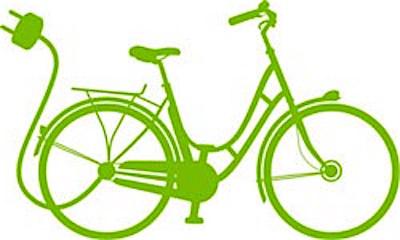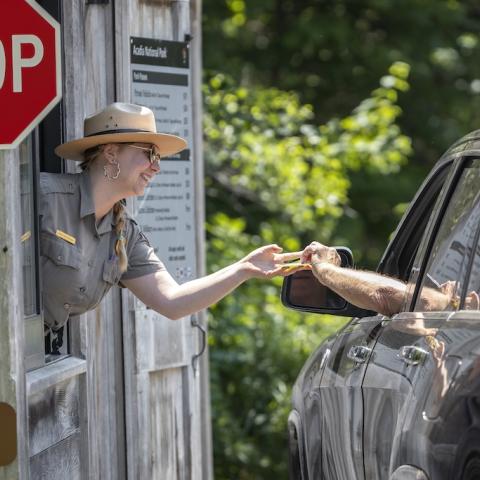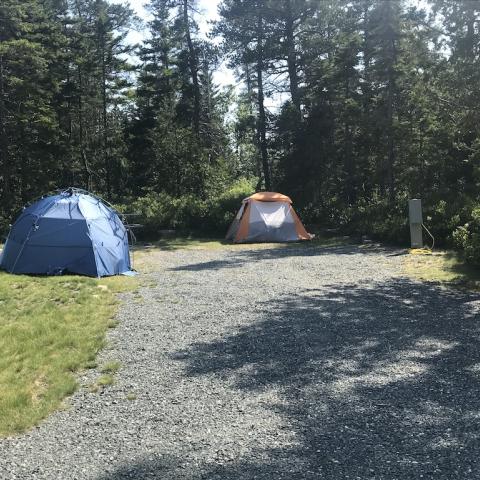
eBike riders caught on the Carriage Roads at Acadia National Park can be fined $130/NPS clipart
Opposition to allowing eBikes on non-motorized trails in the federal lands system has been voiced by dozens of conservation groups, who fear permitting the motorized bikes on those trails will create a "slippery slope" that will lead to future problems with managing those trails.
In a letter to the chief of the U.S. Forest Service, the acting director of the National Park Service, and the acting director of the U.S. Bureau of Land Management, the groups stated that they "oppose any effort that would allow any class of vehicle with a motor – including all classes of e-bikes, which by definition have a motor – to be allowed on non-motorized trails."
The issue came to light earlier this summer at Acadia National Park in Maine, where eBike users were told they could not ride on the Carriage Roads that wind through the park on Mount Desert Island. Fines for those caught on the roads start at $130, according to the park's website.
Discussion of that ban on National Parks Traveler spurred comments from many eBike users who said the bikes allow them to enjoy areas of parks that they normally couldn't walk to due to declining health.
"Apart from ebike commuters, I believe you will find ebikers to be an older, less fit demographic with some medical issues. We are not speed focused. Don't shut us out without at least a trial period," wrote DML.
In Traveler's weekly podcast, Kristen Brengel of the National Parks Conservation Association and Phil Francis of the Coalition to Protect America's National Parks voiced concern over allowing eBikes on non-motorized trails, and said the National Park Service needs to evaluate the issue carefully and fully and, if the decision is made to provide more access to the bikes beyond existing motorized routes, adopt strict regulations that outline where the various classes of eBikes are allowed to travel.
There are three "classes" of eBikes:
* Class 1: eBikes that are pedal-assist only, with no throttle, and have a maximum assisted speed of 20 mph.
* Class 2: eBikes that also have a maximum speed of 20 mph, but are throttle-assisted.
* Class 3: eBikes that are pedal-assist only, with no throttle, and a maximum assisted speed of 28 mph.
"Class 2 may not be suitable for singletrack mountainbike trails - it has been shown that they pose greater physical damage to trails due to the throttle-actuation," writes eBike manufacturer Bosch on its website. "Class 2 may be better suited for multi-use OHV trails designed for more rugged off-road vehicles.
"Class 3 eBikes are typically allowed on roads and on-road bike lanes (“curb to curb” infrastructure), but restricted from bike trails and multiuse paths. While a 20-mph maximum speed is achievable on a traditional bicycle, decision makers and agencies consider the greater top-assisted speed of a Class 3 eBike too fast for most bike paths and trails that are often shared with other trail users."
The conservation organizations, which range from the Addison Oaks Trail Riders to the Yankee Springs Trail Riders Association, say motorized vehicles should be kept separate from trails used by hikers and horseback riders.
"Non-motorized trails were created to ensure that the public could find recreational trail opportunities free from the ever-growing motorization and mechanization," reads the letter. "Millions of public land users including hikers, backpackers, hunters, horse packers, climbers, mountain bikers and many more, value non-motorized trails for recreation. Opening non-motorized trails to motors would forever change the backcountry experience for these users.
"We recognize that e-bikes have a place on public lands and generally should be allowed where motorized vehicles are permitted. The existing motorized trail system provides plentiful opportunities for e-bike use with tens of thousands of miles of trails currently open to their use."
There are groups organized to lobby for greater access for eBikes. PeopleforBikes strives to get more people across the country on bikes, and the growing popularity of eBikes hasn't been overlooked by this group. On their site are a number of papers discussing the benefits of eBikes. One even examines motorized mountain bikes and perceptions about them.
While the popularity of pedal-assist electric bikes (eBikes) generally is growing, electric-mountain bikes (eMTB) have not received a warm welcome by many within the mountain biking community. Anecdotally, a variety of concerns have been raised concerning eMTB use, including trail damage, trail confict, decreased trail access, and the perception that eMTB use is not “real” mountain biking or is “cheating.”
The outcome of that paper was that, "(T)hree predominant themes emerged: What is an eMTB?, Trails, and How should eMTBs be used? There was general confusion about the features and capabilities of eMTBs except by those who had previously used one. Commenters expressed concern over a variety of trail-related issues, including that eMTBs will damage trails similar to the way motorized vehicles do and that they could cause restricted access to some trail systems. There were inconsistent opinions on the use of eMTBs, where some comments saw riding mountain bikes as a 'rite of passage' and that using an eMTB was 'cheating.' There was some level of acknowledgement that eMTBs may be useful for promoting exercise, but this was mediated by the 'rite of passage' belief.'"
According to PeopleForBikes, there already are "more than 300,000 miles of singletrack, doubletrack, and natural surface roads accessible to motorized users."
In their letter of opposition, the conservation organizations wrote that allowing eBikes on non-motorized trails "is ill-advised and would undermine nearly a half century of management precedents and practices. First, allowing e-bikes on non-motorized trails would be un-manageable and send agencies down a slippery slope towards allowing further motorization of trails and potentially the entire backcountry. Federal land managers simply do not have the resources to police e-bikes on trails."
"Second, permitting e-bikes on non-motorized trails is contrary to long-standing 'travel management' laws and policies dating back to the Nixon administration that require all motorized recreational uses of our public lands to be confined to a system of designated roads, trails, and areas. Among other requirements, motorized trails must be located to minimize conflicts with other recreational uses of the public lands, as well as damage to soil, water, and other public land resources and harassment of wildlife."
Currently, the groups concluded, there are multiple opportunities for users to enjoy both motorized and non-motorized opportunities on public lands. However, they added, "(O)pening non-motorized trails to motorized bikes would effectively eliminate the non-motorized, primitive recreational opportunities."
Here's the list of those groups that signed the letter:
Addison Oaks Trail Riders
Allegan County Pleasure Riders
American Endurance Ride Conference
American Hiking Society
American Flyers
Appalachian Trail Conservancy
Back Country Horsemen of America (and the 30 BCH states and 196 chapters, full listing at end)
Bay Area Barns and Trails
Blue Ridge Horsemen's Association
Brighton Trail Riders Association
Canalway Partners-Board Member
Carolina Mountain Club
Colorado Mountain Club
Colorado Plateau Mountain Bike Trail Assoc, Inc.
Conserving Carolina
Continental Divide Trail Coalition
County Line Riders of Catalina, Inc
Dallas Off Road Bicycle Association (DORBA)
East Mountain Regional Trails Council
Fort Custer Horse Friends Association
Grand Valley Trails Alliance
Greater Yellowstone Coalition
Highlands Plateau Greenway
Ice Age Trail Alliance
Idaho Trails Association
Indiana Trails Community
Ionia Horse Trails Association
Kensington Trail Riders
Maybury Trail Riders
Michigan Horse Council
Michigan Trail Riders Association
Montana Wilderness Association
Montana Backcountry Alliance
National Parks Conservation Association
Natural Resources Council of Maine
Nickel Plate Trail, Inc
North Carolina Horse Council
North Country Trail Association Incorporated
Oregon Equestrian Trails
Oregon Horse Council
Overmountain Victory Trail Association
Pacific Crest Trail Association
Partnership for the National Trails System
Pinckney Trail Riders Association
Pisgah Trailblazers
Pontiac Lake Horseman’s Association
Proud Lake Trail Riders
Quiet Trails Group
Rose Oaks Equine Adventurers
San Luis Valley Ecosystem Council
Tri-County Horse Association
The Wilderness Society
Winter Wildlands Alliance
Yankee Springs Trail Riders Association




 Support Essential Coverage of Essential Places
Support Essential Coverage of Essential Places







Comments
What planet are you living on? Motorized trails have systematically and consistantly been closed to motorized use, and reserved for those without a motor. It would be completely accurate to say that tens of thousands of miles of motorized trails have been closed to motorized use.
When you mix in this sort of missinformation, why not just nclude the federal highway system and say there are "millions" of miles of motorized routes available. The subject here is really single track trails, so let's don't delute that to make it look different. Motorized recreationist have less single track available than any other modality.
Its all a giant joke, propegated by people who dont know anything about ebikes or self entitled mountain bikers who dont wish to share the trail with ebikes because they fear they may get crowded. In otherwords only young people who are fit enough are allowed. Class 1 and 2 ebikes do not do any more damege to trails than any biker. Id even argue that class 3 does less damage than class 2. One could argue that narrow tires do far more damage than anything else to sigle track. Ebikes are quiet and most have wider tires than many mountian bikes being used because of the weight. But this is the state of our country where the uniformed and entitled feel they get to control everything.
This made me laugh and its so true, Amen!
Being a 5th generation Montanan and veteran lover of the wild places I'd like to address the eBike issue from the standpoint of an elderly and somewhat disabled person. The bikes are not noisy nor damaging to the environment any more than mountain bikes. Furthermore, by eliminating their use you would be depriving older or less able-bodied persons of the beauty of nature we deserve just as much as younger folks. As a group, we older people have fought and paid for this privilege. On the whole, we are quiet and respectful of the wild places more so than our younger riders. So try a senior or disabled permit system. It would be self-regulating AND generate income for trail maintenance.
I've been montain biking (and an IMBA member) for most of my life (i.e. I'm getting older). I totally recognize that I can no longer do the big epic rides I used to be able to do 25 years ago. THATS LIFE ! Not everybody gets to do everything equally at every stage in life. We all have limitations - physical, economic, social, mental, etc. Some of those we can overcome, some maybe not. Oh well. Yet we can still excersice our "pursuit of happyness" in our own ways. And enjoy nature on our own terms.
It's very simple : ebikes have electric MOTORS. They are therefore MOTORized. They don't belong on non-motorized singletrack trails.
A motor is a motor. Trying to get around it with Class 1,2,3 is just a smokescreen. Besides, in 5 years, batteries will be lighter/cheaper/better, and class 1 bikes willl be obsolete.
And before you call me a luddite.... yes, I plan to buy an e-bike soon. And i'll just ride it on roads and motorized trails. What's wrong with that?
Because your a luddite... no seriously its a rediculous argument. Its like saying that scuba divers shouldnt be allowed in the ocean because they cant hold there breathe long enough, Or that all bikes need to weigh a certain weight because lighter bikes give rich people too much of an advvantage. Its all silly, class 1 ebikes go the same speed or less than a good mountian bike rider, therefore do absolutley no difference to the trail. The whole MOTORized argument was to keep MOTORcycles off the trail that were loud and destroyed the trails. That has all changed, People dont want ebikes on the road too becauswe they dont go fast enough to keep up with traffic, should we just outlqaw them all together beacause an OLD SYSTEM doesnt work. You clearly know nothing about ebikes or you would recognize that, and thats the problem, no actual prooof or reaononableness, no facts and people who know nothing about ebikes screaming MOTOR!!! lol
BTW Class 1 ebikes are already "obsolete as you put it. Almost all class one ebikes are limited intentionally so they stop assisting the rider at 15-20mph, but all of them would be capable of going much faster. Class 1 bikes arent limited by Technology...LOL Again proving the ignorance of your argument. Also saying that people should be limited by age, financial, mental, and physica aspectsl is one of the most biased things I have ever heard its actually funny. Maybe you should go look up the ADA and see how that resonates. I guess we should just not give people jobs because they are handicapped right?!?!?!